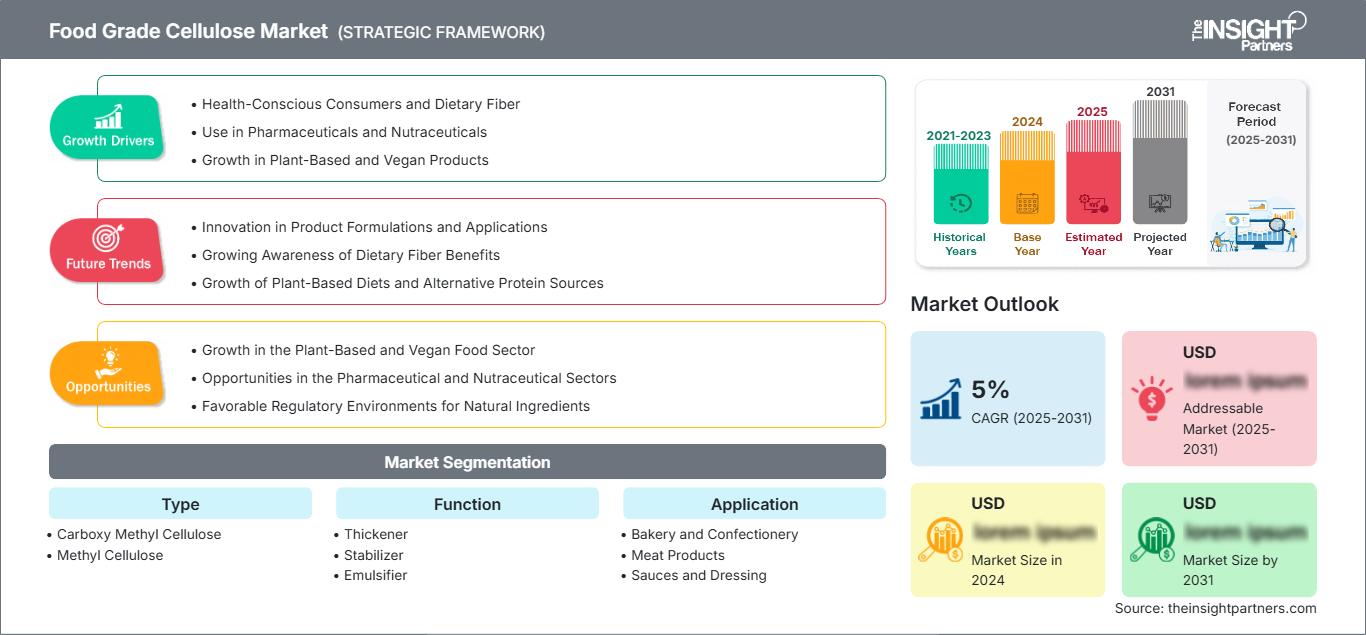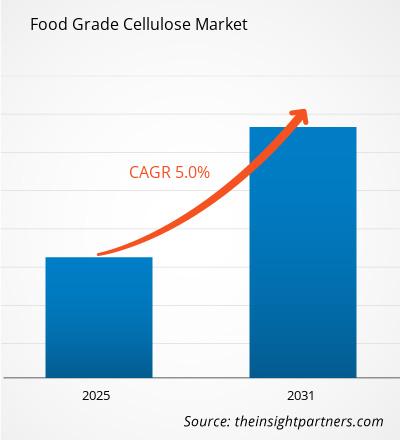Si prevede che il mercato della cellulosa alimentare registrerà un CAGR del 5% dal 2025 al 2031, con una dimensione del mercato in espansione da XX milioni di dollari nel 2024 a XX milioni di dollari entro il 2031.
Il rapporto sul mercato della cellulosa alimentare è segmentato per tipologia in carbossimetilcellulosa e metilcellulosa. Il segmento funzionale include addensanti, stabilizzanti, emulsionanti, filmogeni e agenti sospendenti. Il segmento applicativo include prodotti da forno e dolciumi, prodotti a base di carne, salse e condimenti e prodotti lattiero-caseari. La valutazione del mercato è presentata in dollari USA per l'analisi segmentale di cui sopra. L'analisi globale è suddivisa a livello regionale e per i principali paesi. La valutazione del mercato è presentata in dollari USA per l'analisi segmentale di cui sopra.
Scopo del rapporto
Il rapporto sul mercato della cellulosa alimentare di The Insight Partners mira a descrivere il panorama attuale e la crescita futura, i principali fattori trainanti, le sfide e le opportunità. Ciò fornirà spunti a vari stakeholder aziendali, come:
- Fornitori/produttori di tecnologia: per comprendere le dinamiche di mercato in evoluzione e conoscere le potenziali opportunità di crescita, consentendo loro di prendere decisioni strategiche informate.
- Investitori: per condurre un'analisi completa delle tendenze in merito al tasso di crescita del mercato, alle proiezioni finanziarie del mercato e alle opportunità esistenti lungo la catena del valore.
- Organismi di regolamentazione: per regolamentare le politiche e le attività di controllo nel mercato con l'obiettivo di ridurre al minimo gli abusi, preservare la fiducia degli investitori e sostenere l'integrità e la stabilità del mercato.
Tipo di segmentazione del mercato della cellulosa alimentare
- Carbossimetilcellulosa
- Metilcellulosa
Funzione
- Addensante
- Stabilizzante
- Emulsionante
- Filmante
- Agente di sospensione
Applicazione
- Panetteria e pasticceria
- Prodotti a base di carne
- Salse e condimenti
- Bevande
- Latticini
Geografia
- Nord America
- Europa
- Asia-Pacifico
- America meridionale e centrale
- Medio Oriente e Africa
Potrai personalizzare gratuitamente qualsiasi rapporto, comprese parti di questo rapporto, o analisi a livello di paese, pacchetto dati Excel, oltre a usufruire di grandi offerte e sconti per start-up e università
Mercato della cellulosa alimentare: Approfondimenti strategici

-
Ottieni le principali tendenze chiave del mercato di questo rapporto.Questo campione GRATUITO includerà l'analisi dei dati, che vanno dalle tendenze di mercato alle stime e alle previsioni.
Fattori di crescita del mercato della cellulosa alimentare
- Consumatori attenti alla salute e fibre alimentari: la crescente prevalenza di consumatori attenti alla salute sta spingendo l'adozione di prodotti ricchi di fibre alimentari e la cellulosa, essendo una fonte naturale di fibre alimentari, si allinea perfettamente con questa tendenza in crescita.
- Utilizzo in prodotti farmaceutici e nutraceutici: le industrie farmaceutiche e nutraceutiche consumano quantità significative di cellulosa alimentare, utilizzandola principalmente come eccipiente e sistema di somministrazione per varie formulazioni, aumentandone la domanda di mercato.
- Crescita di prodotti a base vegetale e vegani: la crescente domanda di prodotti a base vegetale e vegani sta alimentando ulteriormente la domanda di cellulosa alimentare, poiché è un ingrediente chiave in prodotti alternativi a base di carne e latticini, contribuendo alla sua crescita di mercato.
Futuro del mercato della cellulosa alimentare Tendenze
- Innovazione nelle formulazioni e nelle applicazioni dei prodotti: la futura crescita del mercato della cellulosa alimentare sarà trainata dalle innovazioni nelle formulazioni e nelle applicazioni dei prodotti, con lo sviluppo di nuovi prodotti studiati su misura per soddisfare specifiche esigenze e preferenze dietetiche.
- Crescente consapevolezza dei benefici delle fibre alimentari: con l'aumento della consapevolezza dei consumatori sui benefici per la salute delle fibre alimentari, aumenterà la domanda di alimenti e integratori ricchi di cellulosa, sostenendo un'ulteriore crescita del mercato della cellulosa alimentare.
- Crescita delle diete a base vegetale e delle fonti proteiche alternative: l'aumento delle diete a base vegetale e delle fonti proteiche alternative offre opportunità per la cellulosa di qualità alimentare come ingrediente versatile in questi prodotti, contribuendo all'espansione del mercato.
Opportunità di mercato della cellulosa di qualità alimentare
- Crescita nel settore alimentare vegano e a base vegetale: la crescente domanda nei settori alimentare vegano e a base vegetale è un fattore chiave per gli ingredienti a base di cellulosa, poiché la cellulosa aiuta a replicare la consistenza e la funzionalità degli ingredienti di origine animale, rendendola un componente essenziale nei prodotti alternativi.
- Opportunità nei settori farmaceutico e nutraceutico: i settori farmaceutico e nutraceutico offrono opportunità di crescita per la cellulosa di qualità alimentare, che viene utilizzata come eccipiente e sistema di somministrazione, contribuendo al suo utilizzo esteso oltre le applicazioni alimentari.
- Ambienti normativi favorevoli per gli ingredienti naturali: il favorevole Gli ambienti normativi in tutto il mondo che incoraggiano l'uso di ingredienti naturali e sostenibili andranno a vantaggio del mercato della cellulosa di grado alimentare, poiché gli enti normativi supportano l'adozione di questi ingredienti in vari settori.
Mercato della cellulosa per uso alimentare
Le tendenze regionali e i fattori che influenzano il mercato della cellulosa alimentare durante il periodo di previsione sono stati ampiamente spiegati dagli analisti di The Insight Partners. Questa sezione illustra anche i segmenti e la geografia del mercato della cellulosa alimentare in Nord America, Europa, Asia-Pacifico, Medio Oriente e Africa, America meridionale e centrale.
Ambito del rapporto sul mercato della cellulosa per uso alimentare
| Attributo del rapporto | Dettagli |
|---|---|
| Dimensioni del mercato in 2024 | US$ XX million |
| Dimensioni del mercato per 2031 | US$ XX Million |
| CAGR globale (2025 - 2031) | 5% |
| Dati storici | 2021-2023 |
| Periodo di previsione | 2025-2031 |
| Segmenti coperti |
By Tipo
|
| Regioni e paesi coperti |
Nord America
|
| Leader di mercato e profili aziendali chiave |
|
Densità degli operatori del mercato della cellulosa alimentare: comprendere il suo impatto sulle dinamiche aziendali
Il mercato della cellulosa alimentare è in rapida crescita, trainato dalla crescente domanda da parte degli utenti finali, dovuta a fattori quali l'evoluzione delle preferenze dei consumatori, i progressi tecnologici e una maggiore consapevolezza dei benefici del prodotto. Con l'aumento della domanda, le aziende stanno ampliando la propria offerta, innovando per soddisfare le esigenze dei consumatori e sfruttando le tendenze emergenti, alimentando ulteriormente la crescita del mercato.

- Ottieni il Mercato della cellulosa alimentare Panoramica dei principali attori chiave
Punti di forza
- Copertura completa: il rapporto analizza in modo esaustivo prodotti, servizi, tipologie e utenti finali del mercato della cellulosa alimentare, offrendo una panoramica olistica.
- Analisi degli esperti: il rapporto è redatto sulla base della conoscenza approfondita di esperti e analisti del settore.
- Informazioni aggiornate: il rapporto garantisce la pertinenza aziendale grazie alla copertura di informazioni e tendenze dei dati recenti.
- Opzioni di personalizzazione: questo rapporto può essere personalizzato per soddisfare le esigenze specifiche del cliente e adattarsi in modo appropriato alle strategie aziendali.
Il rapporto di ricerca sul mercato della cellulosa alimentare può quindi contribuire a guidare il percorso di decodificazione e comprensione dello scenario del settore e delle prospettive di crescita. Sebbene possano esserci alcune preoccupazioni valide, i vantaggi complessivi di questo rapporto tendono a superare gli svantaggi.
- Analisi storica (2 anni), anno base, previsione (7 anni) con CAGR
- Analisi PEST e SWOT
- Valore/volume delle dimensioni del mercato - Globale, Regionale, Nazionale
- Industria e panorama competitivo
- Set di dati Excel
Report recenti
Rapporti correlati
Testimonianze
Motivo dell'acquisto
- Processo decisionale informato
- Comprensione delle dinamiche di mercato
- Analisi competitiva
- Analisi dei clienti
- Previsioni di mercato
- Mitigazione del rischio
- Pianificazione strategica
- Giustificazione degli investimenti
- Identificazione dei mercati emergenti
- Miglioramento delle strategie di marketing
- Aumento dell'efficienza operativa
- Allineamento alle tendenze normative






















 Ottieni un campione gratuito per - Mercato della cellulosa alimentare
Ottieni un campione gratuito per - Mercato della cellulosa alimentare